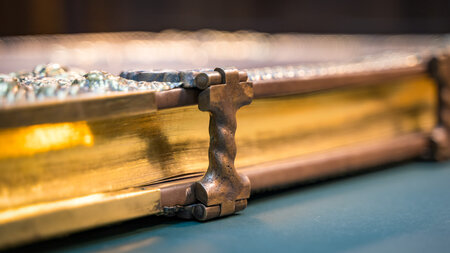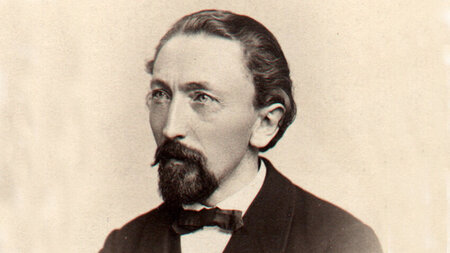Eintrag in der Universitätsbibliographie der TU Chemnitz
Anodische Oxidation von kupferhaltigen Aluminiumlegierungen
Anodic oxidation of copper-alloyed aluminum
Kurzfassung in deutsch
Hochfeste kupferhaltige Aluminiumlegierungen gelten gemeinhin als „schwer“ anodisierbar, deshalb werden in der vorliegenden Arbeit werkstoffseitige und prozessseitige Maßnahmen zur Verbesserung der Schichtqualität erforscht. Zur eindeutigen Abgrenzung des Einflusses der Cu-Verteilung vom Einfluss anderer Legierungselemente und Verunreinigungen wurde für die Anodisierexperimente zusätzlich zur kommerziellen Legierung EN AW-2024 die hochreine Modelllegierung AlCu4 als Untersuchungswerkstoff gewählt. Insbesondere für die Modelllegierung AlCu4 konnte erstmals eine systematische Veränderung des Schichtbildungsmechanismus beschrieben werden. Mit zunehmender Ausscheidungsbildung nimmt das Ausmaß der Sauerstoffentwicklung ab, woraus erhöhte Schichtdicken und -härten folgen. Die nach Anodisieren der warmausgelagerten Zustände erhaltenen Schichtmikrostrukturen wurden erstmals im Rahmen dieser Arbeit mittels Rasterelektronenmikroskopie beschrieben. Aufgrund reduzierter Schichtrücklösung sind auch auf der Legierung EN AW-2024 im warmaus-gelagerten und überalterten Zustand höhere Schichtdicken und -härten für eine Elektrolyttemperatur von 20 °C erzielbar. Bei einer Elektrolyttemperatur von 5 °C können die Schichtdicke und -härte vor allem durch Zugabe von Additiven zum schwefelsauren Grundelektrolyt gesteigert werden. Im Unterschied zu konventionellen organischen Additiven resultiert die Zugabe von Salpetersäure darüber hinaus in einer Absenkung der Anodisierspannung zu Prozessbeginn und damit in einer Reduzierung der erforderlichen elektrischen Energie. Mit steigender Additivkonzentration nimmt jedoch die Ritzbeständigkeit der Schichten infolge erhöhter Mikrorissigkeit ab. Es ist folglich ein Optimum aus Schichthärte und Mikrorissigkeit zu finden.
Kurzfassung in englisch
High-strength aluminum-copper alloys are generally recognized to be “hardly” anodizable. Hence, the influences of material and process parameters were investigated within this work in order to improve the coating properties. Apart from the commercial alloy EN AW-2024, the high purity model alloy AlCu4 was used for the anodizing experiments in order to distinguish between the influence of the copper distribution and the influence of other alloying elements and impurities. Regarding the model alloy AlCu4, a systematic change of the coating growth mechanism was described for the first time. The extent of oxygen evolution decreases with the intensification of the precipitation leading to increased coating thickness and hardness. In this work, the coating microstructures, resulting from the anodic oxidation of the artificially aged conditions, were described by scanning electron microscopy, for the first time. Due to reduced chemical dissolution of the coatings, higher coating thickness and hardness can also be achieved after room-temperature anodizing of the alloy EN AW-2024 in the artificially aged conditions. For hard-anodizing at an electrolyte temperature of 5 °C, the coating thickness and hardness can be particularly improved by using additives in combination with the sulfuric acid base electrolyte. Beyond that and in contrast to the effect of conventional organic additives, the addition of nitric acid enables the reduction of the anodizing voltage at the beginning of the process and therefore, the reduction of the required electrical energy. However, the scratch resistance of the coatings decreases with increasing additive concentration due to the occurrence of micro crack networks. Consequently, the coating hardness and the amount of microcracks have to be optimized in order to meet concrete application requirements.
| Universität: | Technische Universität Chemnitz | |
| Institut: | Professur Werkstoff- und Oberflächentechnik | |
| Fakultät: | Fakultät für Maschinenbau | |
| Dokumentart: | Dissertation | |
| Betreuer: | Lampke, Thomas, (Univ.-Prof. Dr.-Ing. habil.) | |
| URL/URN: | https://nbn-resolving.org/urn:nbn:de:bsz:ch1-qucosa2-356996 | |
| Quelle: | Chemnitz : TU Chemnitz, 2019. - 143 S. | |
| SWD-Schlagwörter: | Anodische Oxidation , Mikrostruktur , Werkstoffkunde , Energieeffizienz | |
| Freie Schlagwörter (Deutsch): | Aluminium-Kupfer-Legierungen , anodische Oxidation , Ausscheidungen , Schichtmikrostruktur , mechanische Schichteigenschaften , Energieeffizienz | |
| Freie Schlagwörter (Englisch): | aluminum-copper alloys , anodic oxidation , precipitations , coating microstructure , mechanical coating properties , energy efficiency | |
| DDC-Sachgruppe: | Ingenieurwissenschaften | |
| Sprache: | deutsch | |
| Tag der mündlichen Prüfung | 07.10.2019 |




